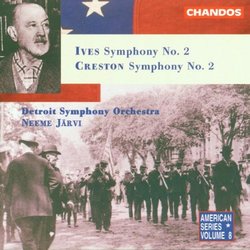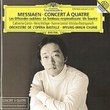| All Artists: Ives, Creston, Jarvi, Detroit Symphony Orch. Title: Ives: Symphony No. 2 / Creston: Symphony No. 2 Members Wishing: 1 Total Copies: 0 Label: Chandos Release Date: 9/19/1995 Genre: Classical Styles: Historical Periods, Modern, 20th, & 21st Century, Symphonies Number of Discs: 1 SwapaCD Credits: 1 UPC: 095115939024 |
Search - Ives, Creston, Jarvi :: Ives: Symphony No. 2 / Creston: Symphony No. 2
 | Ives, Creston, Jarvi Ives: Symphony No. 2 / Creston: Symphony No. 2 Genre: Classical
This release is part of Chandos's excellent American Music Series (#8) and it features two fine readings of works by Creston and Ives. Neeme Jarvi seems able to conduct just about any composer with feeling (is there anyb... more » |
Larger Image |
CD DetailsSynopsis
Amazon.com This release is part of Chandos's excellent American Music Series (#8) and it features two fine readings of works by Creston and Ives. Neeme Jarvi seems able to conduct just about any composer with feeling (is there anybody he hasn't put his baton to?), and the Ives here is handled with reverence and skill. But the Creston is the true standout, since he doesn't get the kind of attention these days that he deserves. His Symphony 2 (1945) is confident and stately in its unfolding. His music falls right in there with Roy Harris, Howard Hanson, and Walter Piston. --Paul Cook Similar CDs
Similarly Requested CDs
|
CD ReviewsAn ?Odd Couple? of Great American Symphonies Eugene G. Barnes | Dunn Loring, VA USA | 03/09/2001 (5 out of 5 stars) "The Ives Second Symphony is a largely tuneful work; in fact it is made up of wisps and fragments of tunes popular at the time Ives wrote it. But it's far more than a clever pastiche. Ives weaves the tunes together in a way that causes them to build, one upon another, and the whole thing ends in an ultimate, life-affirming, joyous rendering of "O Columbia, the Gem of the Ocean."Since Leonard Bernstein gave the premiere of the painstakingly reconstructed work in 1951, the Bernstein recordings have always been given pride of place among all existing recordings. But this is one piece where there's plenty of room for widely differing interpretations, and anyway I'm coming to feel that Bernstein's realization can be embarrassingly unsubtle at times. Suffice it to say, regarding the present recording, Estonian conductor Neeme Jarvi "got it." That is, he correctly understands the music and addresses it from the right perspective, letting the work's beauty and playfulness speak for itself. And where Bernstein practically plods along in the final movement, Jarvi takes it at a good healthy clip, a breath of fresh air for sure. Jarvi's is also a bit better than Michael Tilson Thomas' performance with the Concertgebouw Orchestra of Amsterdam (Sony Classical). (MTT also takes the final movement at a hot tempo, but then he rushed some other passages for no apparent reason.)The booklet accompanying the CD tells us that Paul Creston's Second Symphony (1945) is probably the most durable of all Creston's works, and I have, in fact, participated in discussions about whether this is indeed THE Great American Symphony. It is certainly a strong contender. It's short (at 22 minutes) but jam-packed with the kind of rhythmic vitality that is Creston's hallmark. The Detroit Symphony gives it a sumptuous, spacious, utterly committed reading, with the edges a bit smoother than those of the Ukrainians on Naxos.The Ives and Creston make for two odd bedfellows on this CD, appealing as they do to very different aesthetic senses. But they both, in their own way, satisfy immensely, over time with repeated listenings. I just can't imagine playing them back-to-back is all. Buy it and transport yourself back to a time when people would be happy to tell you that the term "post-modern" really is as dumb as it sounds..."
|

 Track Listings (7) - Disc #1
Track Listings (7) - Disc #1





